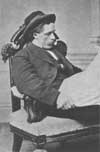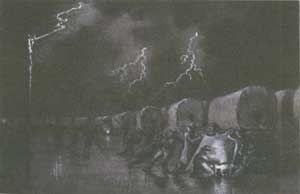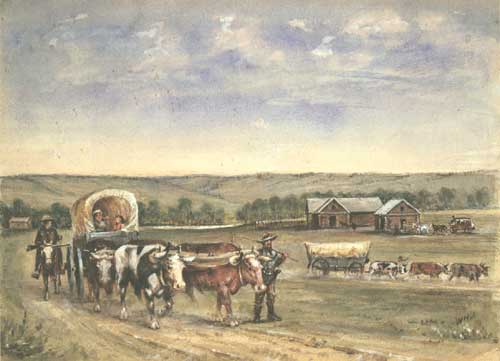
INTRODUCTION
By Marian Albright Schenk
FOREWORD
By Dean Knudsen
SECTION 1
Primary Themes of Jackson's Art
SECTION 2
Paintings of the Oregon Trail
SECTION 3
Historic Scenes From the West
 |
| Such relaxed moments as portrayed in this informal portrait of Jackson, dated 1869-1870, were rare. Besides operating a photographic studio in Omaha, Nebraska, he married Mollie Greer on May 10, 1869, and the next year he accompanied the U.S. Geological Survey on its first expedition to the Yellowstone country in Wyoming. (SCBL 3058) |

Section 2: Paintings of the Oregon Trail
EMIGRANTS ON THE TRAIL
Rock Creek Station, also known as East Ranch, is located near present-day Endicott, Nebraska. This historic site once served as a Pony Express and stage station, but is probably most famous for having been the site of a gunfight between James Butler Hickok and David McCanles. The story is told that on July 12, 1861, David McCanles, the owner of Rock Creek Station and two of his hired men were shot and killed by "Wild Bill" Hickok. Circumstances surrounding the fight are unclear, but Hickok later became a famous shootist and lawman.
Such violence made for good reading in the pulp novels of the day, and thanks to Hollywood's vision of the West, gun play is generally accepted to have played a major role in America's westward expansion. However, in reality, the greatest threat of violent death did not come from gunfighters, but rather from the accidental discharge of firearms in the hands of inexperienced travelers.
Perhaps wishing to emphasize the unrelenting exertions of the emigrants on the Oregon Trail, as opposed to the murderous violence that was only an occasional occurrence in the westward movement, Jackson has ignored the Hickok story altogether, and chosen to portray an ox team passing peacefully by Rock Creek Station.
 |
| Lightning Storm. By using black ink and a few dabs of white paint Jackson captured a group of wet and miserable emigrants as they are startled by lightning striking a nearby telegraph pole. (SCBL 122) |
This particular painting provides a number of details about the use of oxen. One advantage pioneers had in using oxen to pull their wagons was the relative simplicity of the hardware that was required. Unlike mules and horses, no special harness, halters and reins were needed. The oxen were placed in heavy wooden yokes, which were attached directly to the tongue of the wagon. The oxen were guided by a bullwhacker who walked alongside the teams.
As can also be seen in the painting, the number of teams used could vary. Heavier wagons, such as the one in the background, would require more oxen (in this case 3 yokes), while the lighter wagon in the foreground only needed two. It was unusual for emigrants to ride in their wagons, as this added to the strain on their draft animals. It was more common for people to walk alongside the wagons.
For people making their way west, there was another type of violence that intimidated them—that of the weather. Nothing in their experience in the East prepared them for the sudden violence that erupts on the High Plains. Diaries and journals are full of comments about the power and fury of the thunderstorms which would seemingly form in a matter of minutes and buffet the pioneers with torrential rains, high winds, sheet lightning, and hailstones.
Jackson experienced such a storm just after crossing the South Platte River and described the event:
Then, almost in a moment, the sky filled with black clouds and a strong east wind blew upon us. . . The storm grew more furious. Our wagons rocked in the gale, and it seemed that we must surely be turned over; and only the tons of goods under the cover kept us upright, and at that, we were blown some little distance in our tracks. The rain beat down so hard that it came through the canvas roof as if it had been a sieve. . .
1. Jackson, Time Exposure, 121-122.
 |
| Rock Creek Station. Initialed and undated. 26.0 x 36.2 cm. (SCBL 21) |
 |
scbl/knudsen/sec2b.htm Last Updated: 14-Apr-2006 |
 |